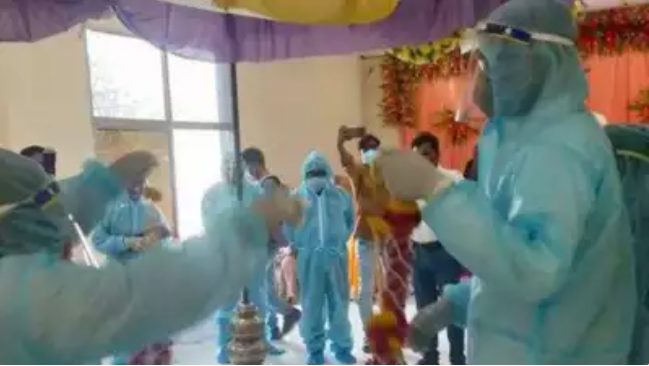In the past 24 hours, India’s new record number of new confirmed cases has reached 386,000, according to data released today by the Ministry of Health. More than 300,000 new confirmed cases were confirmed in nine consecutive days. Due to the surge in confirmed cases, the situation of the epidemic has deteriorated rapidly, medical resources are frequently urgent, of which medical oxygen has become the most important and most scarce material.
Mumbai doctor Trupti: We don’t have oxygen anymore. It’s hard to imagine a worse situation than it is now.
A woman sobbs outside an oxygen plant in New Delhi. On the morning of the 28th, because of his mother’s serious illness, Saha waited in line here all night for oxygen, oxygen did not wait, but waited for the news of her mother’s death.
The patient’s family member Saha: I went out at 2 o’clock at night and there was no oxygen supply in Delhi. We ran for a long time, arrived here at three or four o’clock, and ended up in a queue here. I said save my mother first, and they told me to get a doctor’s or a hospital prescription. My mother is in critical condition and we have run a lot of hospitals to find beds in the past two days.
Some people are forced to go to the black market to buy oxygen for their loved ones.
Reporter: Who’s the oxygen for?
Family: My grandmother.
Reporter: How sick is she?
Patient’s family: If we don’t give her oxygen, she’ll die in the hospital, which is no longer oxygen.
In the emergency room of a New Delhi hospital, a woman sat powerlessly by her husband’s bedside, and her mother died of Coronavirus. Her husband was also diagnosed and is in a critical condition. At this moment, she has not been able to come out of the grief of her mother’s death.
Family member Monica Goel: My mother passed away this morning because there was no ventilator. If anything, maybe she’ll live. Now he (my husband) needs ventilator support, and the doctor says we have two days left, and I’ve tried my best.
Dr. Sumit Rai, director of the intensive care unit: “We now have too many patients in our hospital that we are beyond the reach of the intensive care unit.” We put a stretcher between the beds, our ventilators ran out, and we were using an anaesthetic machine to oxygen the patient.
Not only New Delhi, India’s most populous state, rural areas and some smaller cities are also facing severe oxygen shortages, with many hospitals posting signs advising families to coordinate medical oxygen. Outside the oxygen plant in rural India, people carrying gas cylinders lined up, but there was no oxygen.
Oxygen production and filling facilities in rural India are currently overwhelmed by excessive demand. A large number of factories have stopped producing industrial oxygen, focused only on oxygen filling medical oxygen cylinders, and are ramping up transportation supplies. Even so, oxygen is in short supply.
Family member Dixit: I’ve been waiting here for 48 hours, and all these people with loved ones infected and hospitalized are lining up here to get oxygen and save lives. The government says there’s oxygen in the papers, but that’s not the case.
Family member Tahir: My sister died of lack of oxygen on April 23 and my brother is in a terrible condition. Oxygen is available only to those who are in a high position and are familiar with the oxygen plant. We’ve been standing here for hours and no one’s talking.
Indian media: Inadequate transport capacity leads to national “hypoxia”
The worsening outbreak has left India’s health-care system on the brink of collapse, particularly with severe “oxygen deficiency”. Without oxygen, patients can’t survive for a few minutes, so why is India’s medical oxygen “difficult to find”? Indian media pointed out that India is not without oxygen, but not easy to get to the hospital in time, transport difficulties are the crux of India’s “lack of oxygen”.
India actually has plenty of oxygen capacity, but is being dragged back by “transport capacity,” according to the Indian Express.
While the vast majority of India’s oxygen-producing factories are located in the east, cities such as New Delhi and Mumbai, which are currently hard hit by the outbreak, are located in northern and western India and require long-distance transportation. The transportation of medical oxygen needs some transportation and infrastructure support.
The transportation conditions of medical liquid oxygen are more stringent. First, special tankers for transporting and storing liquid oxygen are required. In India, the number of such special tankers is limited, and the worsening of Coronavirus pandemic has led to an explosion in oxygen demand. India currently has only 1,224 vehicles capable of transporting liquid oxygen, with a total capacity of more than 16,000 tons. The current demand is more than 7,000 tons per day, which seems to be sufficient transport capacity, although these vehicles often take six days to travel by long distance, which means that the daily transport capacity is less than 3,000 tons, far from meeting the oxygen demand.
In addition, filling with oxygen is a time-consuming process. Oxygen tankers usually line up outside the plant for hours, while filling a liquid oxygen tank takes about two hours. For safety reasons, oxygen tankers must not travel faster than 40 km/h and usually need to avoid driving at night.



